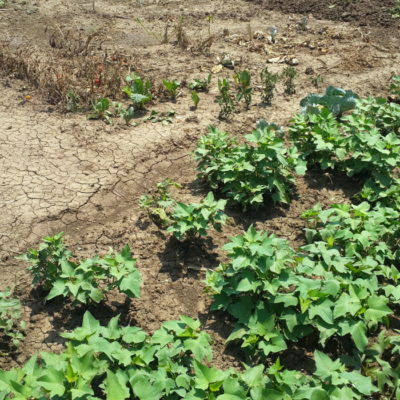
Droughts have long posed a threat to farmers in southern Africa, and models predict they will become more frequent, unpredictable, and intense as global warming continues. Drought-tolerant sweetpotato varieties have proven to be lifesavers for farmers who lose their maize or other crops for lack of rain. For this reason, more climate-resilient sweetpotato varieties with characteristics consumers want are urgently needed and this is why drought tolerance is a priority target at the regional sweetpotato breeding platform in Mozambique.
Field trials in Mozambique to evaluate an array of local varieties and breeding parents not only identified some with high levels of drought tolerance, but also served as an opportunity to test the use of drones equipped with sensors to study sweetpotato plants’ responses to water stress on a large scale – an approach with potential to accelerate breeding in the future.
The research is described in an article recently published in the Journal of Agronomy and Crop Science. The investigation consisted of two large field trials with a total of 144 breeding parents and popular varieties over two seasons – one hot and rainy and the other dry and cold – during which drought conditions were induced at different points to assess how plants respond to water stress. Using visible spectrum and thermal cameras on drones flown over the fields, scientists recorded changes in plants’ chlorophyll levels and the temperature of their leaf canopies, both of which change in response to drought stress. Those changes were then correlated with the amount of foliage and sweetpotatoes they produced.
While breeders have documented common characteristics of drought-tolerant sweetpotato plants, such as smaller leaves and thicker stems, the establishment of indicators measured by sensors on a drone could provide real-time information that scientists can use to select likely candidates for new varieties.
“Understanding how crops behave under different water restriction contexts is fundamental for plant breeding,” observes CIP scientist David Ramirez, a crop ecophysiologist and the article’s lead author. “One of the things we’ve done is to shed light on the mechanisms of drought tolerance,” he adds.
Ramirez explains that the study included simulation of drought conditions at different points in the crop cycle – early, mid- or late-season – to document how different varieties were affected. The results confirmed that while drought early in the crop cycle tends to reduce yield, drought late in the season actually produces higher yields in some varieties. And whereas most varieties yield well when there is sufficient rain, and some yield well in drought conditions, the study allowed researchers to identify a few varieties that produce well in both drought and high-rainfall scenarios, and thus have the potential to boost the resilience of farmers in areas where rain cycles are inconsistent or unpredictable.

While images and temperature readings taken from a drone can be used to predict how drought stress affects a plants’ foliage production, which is important for dual-use sweetpotatoes used to produce both food and livestock fodder, Ramirez noted that additional research and tools are needed to correlate those indicators to a plant’s sweetpotato production.
“The challenge remains to develop more effective methods, analyses and models to correlate the changes in plants’ foliage observed in this study with the development of sweetpotatoes,” he says, adding that this may require the use of technologies able to measure changes underground.
Hugo Campos, CIP Director of Research, notes that this marked the first time CIP’s remote sensing and breeding teams collaborated on the design and execution of research for the development of climate-resilient sweetpotato. He explains that using drones could be a non-intrusive, affordable, high-throughput way to identify drought tolerant plants in a field packed with diversity, as is the case with breeding trials. The resulting data could help scientists select the best candidates for release to farmers more quickly, since they wouldn’t need to wait for a crop to mature to determine which plants are drought tolerant.
“This is very significant, because drone-based monitoring not only reduces the time and labor needed to collect data during field trials, it also increases the quality and reliability of the data, because it reduces the likelihood of human error,” says Campos.

“This proof of concept can be applied to crops other than sweetpotato, particularly crops that produce edible roots or tubers,” he adds, noting that drone-based data collection fits into CGIAR’s goal of accelerating the development and adoption of superior varieties.
Ramirez, observes that large-scale farms and the agro-export sector are already exploiting the potential of drones and artificial intelligence to evaluate crops and harvests – an example of the digital transformation of agriculture – but the cost of such technologies has thus far kept them out of reach of small-scale farmers, which makes the development or adaptation of less expensive options vital. He adds that as different research centers collaborate more closely under One CGIAR, there will be more opportunities for knowledge sharing and technology transfer in this area.
“The challenge facing One CGIAR is to drive a digital transformation that benefits small-scale farmers,” Ramirez says.
This research was funded by the Foreign, Commonwealth and Development Office, UK, the Bill and Melinda Gates Foundation, the CGIAR Research Program on Roots, Tubers and Bananas (RTB), and CGIAR Trust Fund contributors (https://www.cgiar.org/funders/).
